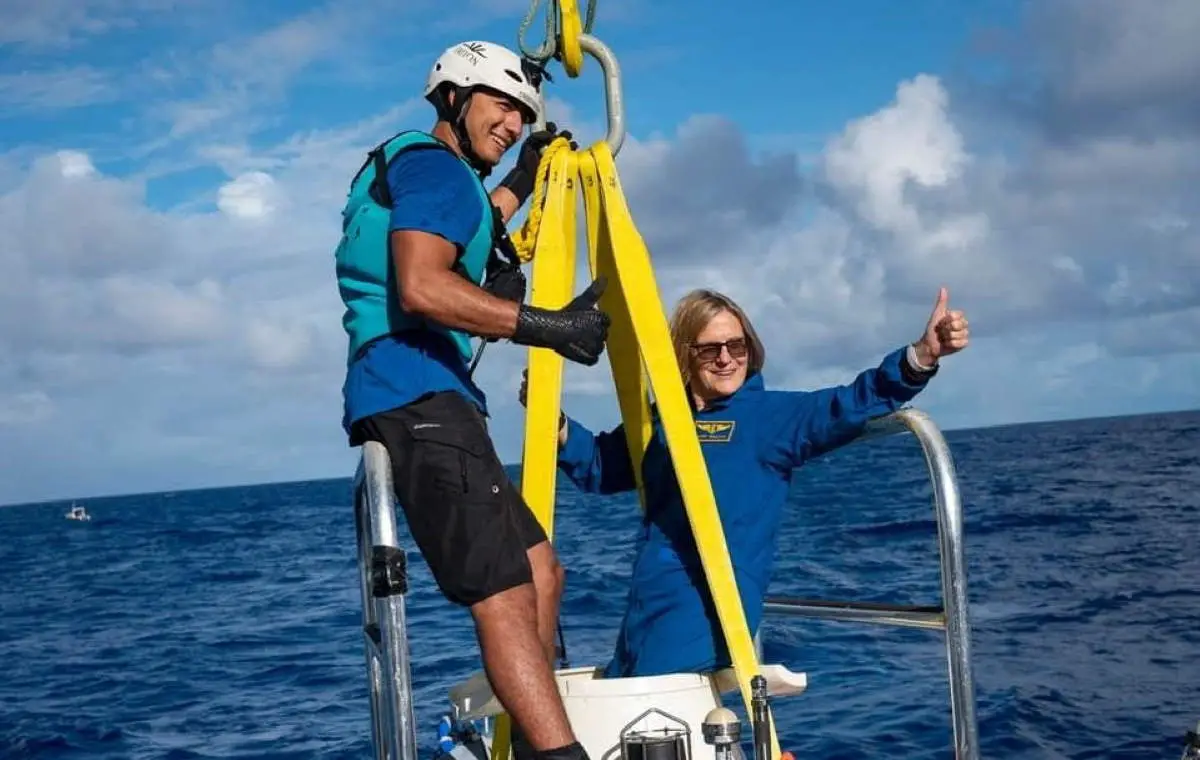Kathryn Sullivan, the first American woman to walk in space on October 11, 1984, now also becomes the first woman to reach the deepest point of the ocean, the Challenger Deep, at the southern end of the Mariana Trench. She also became only the eighth person ever to reach the Challenger Deep.
Kathryn Sullivan, the first woman to reach the Challenger Deep

On June 7, 2020, Sunday, Kathryn Sullivan traveled on an expedition aboard the Triton Submarines DSV Limiting Factor to the bottom of the Challenger Deep (see notes 1) at the southern end of the Mariana Trench, the deepest known point in the ocean, becoming the first woman to reach the deepest known point in the ocean and the first person to travel to both Challenger Deep and to space.
When While Sullivan’s vessel was at the bottom of the deepest point of the ocean, a call was made between the vessel and astronauts aboard the International Space Station. The call was an homage to her other historic adventure when she became the first American woman to walk in space on October 11, 1984.
Dr. Sullivan was accompanied by Victor L. Vescovo during her journey, an explorer funding the mission. They spent about an hour and a half at the deepest point of the ocean.
On her website, Dr. Sullivan published a post titled “Success!” on June 7 and said “Journey to the bottom of the Challenger Deep – and back.”

Related: How deep is the ocean?
Kathryn Sullivan

Kathryn Dwyer Sullivan was born on October 3, 1951, in Paterson, New Jersey. She was awarded a Bachelor of Science degree in Earth Sciences from the University of California, Santa Cruz in 1973, and a Ph.D. in Geology from Dalhousie University in 1978.
She was awarded a Bachelor of Science degree in Earth Sciences from the University of California, Santa Cruz in 1973, and a Ph.D. in Geology from Dalhousie University in 1978. She participated in several oceanographic expeditions that studied the floors of the Atlantic and Pacific oceans while at Dalhousie.
Dr. Kathryn Sullivan joined NASA in 1978 and was part of the first astronaut groups to include women. She became an astronaut in August 1979 and performed the first spacewalk (extra-vehicular activity, EVA) by an American woman during Space Shuttle Challenger mission STS-41-G on October 11, 1984. Sullivan and mission specialist David Leestma performed a 3.5-hour spacewalk in which they operated a system designed to show that a satellite could be refueled in orbit.

Kathy Sullivan is a veteran of three shuttle missions and a 2004 inductee to the Astronaut Hall of Fame.
In 1993, Dr. Sullivan left NASA to accept a Presidential appointment to the post of Chief Scientist at the National Oceanic and Atmospheric Administration (NOAA). Here she oversaw a wide array of research and technology programs ranging from climate and global change to satellites and marine biodiversity.
From 1996 to 2006, she served as President and CEO of COSI (Center of Science & Industry) in Columbus, Ohio. Under her leadership, COSI strengthened its impact on science teaching in the classroom and its national reputation as an innovator of hands-on, inquiry-based science learning resources.
She then served as the inaugural Director of the Battelle Center for Mathematics and Science Education Policy in the John Glenn School of Public Affairs at The Ohio State University.
Dr. Kathryn Sullivan was confirmed by the Senate as the Under Secretary of Commerce for Oceans and Atmosphere and NOAA Administrator on March 6, 2014, having served as Acting NOAA Administrator since February 28, 2013.
In November 2019, Sullivan’s book Handprints on Hubble: An Astronaut’s Story of Invention was released from MIT Press. ”Handprints on Hubble” recounts Sullivan’s experience as part of the team that launched, rescued, repaired, and maintained the Hubble Space Telescope.
Notes
- The Challenger Deep is the deepest known point in the Earth’s seabed hydrosphere (the oceans), with a depth of 10,902 to 10,929 m (35,768 to 35,856 ft) by direct measurement from deep-diving submersibles, remotely operated vehicles and benthic landers and (sometimes) slightly more by sonar bathymetry. It was discovered by the H.M.S. Challenger, a British ship that sailed the globe from 1872 to 1876 and named after the ship.
Sources
- Kathryn D. Sullivan on Wikipedia
- Challenger Deep on Wikipedia
- “First American woman to walk in space now the first woman to reach the deepest point of the ocean” on the NBC News website
- “First American Woman to Walk in Space Reaches Deepest Spot in the Ocean” on The New York Times website
- “Kathy Sullivan: The woman who’s made history in sea and space” on BBC
- Moon Landings: All-Time List [1966-2025] - February 2, 2025
- What Is Max-Q and Why Is It Important During Rocket Launches? - January 16, 2025
- Top 10 Tallest Rockets Ever Launched [2025 Update] - January 16, 2025
